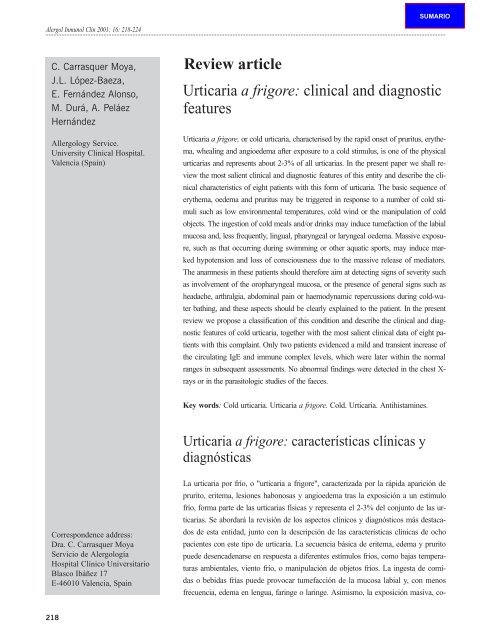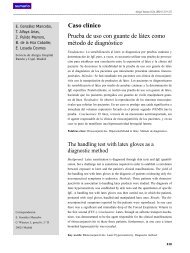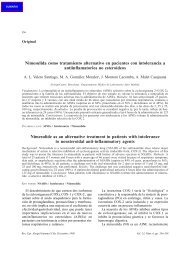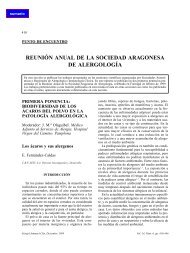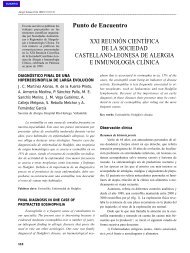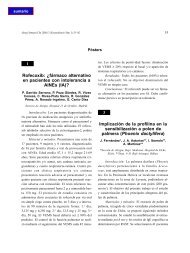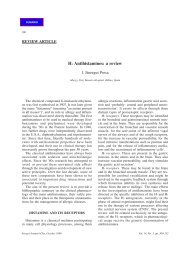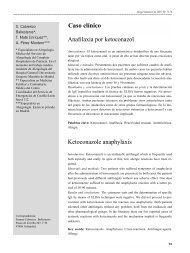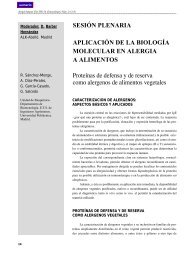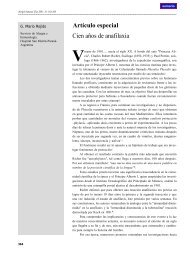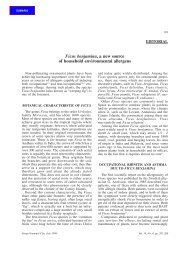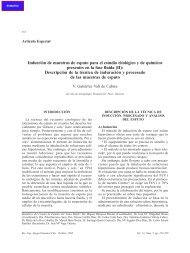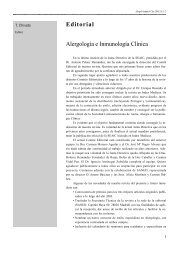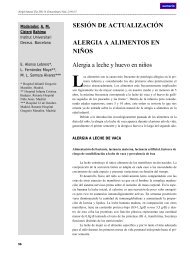a frigore - Alergología e Inmunología Clínica
a frigore - Alergología e Inmunología Clínica
a frigore - Alergología e Inmunología Clínica
Create successful ePaper yourself
Turn your PDF publications into a flip-book with our unique Google optimized e-Paper software.
Alergol Inmunol Clin 2001; 16: 218-224<br />
C. Carrasquer Moya,<br />
J.L. López-Baeza,<br />
E. Fernández Alonso,<br />
M. Durá, A. Peláez<br />
Hernández<br />
Allergology Service.<br />
University Clinical Hospital.<br />
Valencia (Spain)<br />
Correspondence address:<br />
Dra. C. Carrasquer Moya<br />
Servicio de <strong>Alergología</strong><br />
Hospital Clínico Universitario<br />
Blasco Ibáñez 17<br />
E-46010 Valencia, Spain<br />
218<br />
Review article<br />
Urticaria a <strong>frigore</strong>: clinical and diagnostic<br />
features<br />
Urticaria a <strong>frigore</strong>, or cold urticaria, characterised by the rapid onset of pruritus, erythema,<br />
whealing and angioedema after exposure to a cold stimulus, is one of the physical<br />
urticarias and represents about 2-3% of all urticarias. In the present paper we shall review<br />
the most salient clinical and diagnostic features of this entity and describe the clinical<br />
characteristics of eight patients with this form of urticaria. The basic sequence of<br />
erythema, oedema and pruritus may be triggered in response to a number of cold stimuli<br />
such as low environmental temperatures, cold wind or the manipulation of cold<br />
objects. The ingestion of cold meals and/or drinks may induce tumefaction of the labial<br />
mucosa and, less frequently, lingual, pharyngeal or laryngeal oedema. Massive exposure,<br />
such as that occurring during swimming or other aquatic sports, may induce marked<br />
hypotension and loss of consciousness due to the massive release of mediators.<br />
The anamnesis in these patients should therefore aim at detecting signs of severity such<br />
as involvement of the oropharyngeal mucosa, or the presence of general signs such as<br />
headache, arthralgia, abdominal pain or haemodynamic repercussions during cold-water<br />
bathing, and these aspects should be clearly explained to the patient. In the present<br />
review we propose a classification of this condition and describe the clinical and diagnostic<br />
features of cold urticaria, together with the most salient clinical data of eight patients<br />
with this complaint. Only two patients evidenced a mild and transient increase of<br />
the circulating IgE and immune complex levels, which were later within the normal<br />
ranges in subsequent assessments. No abnormal findings were detected in the chest Xrays<br />
or in the parasitologic studies of the faeces.<br />
Key words: Cold urticaria. Urticaria a <strong>frigore</strong>. Cold. Urticaria. Antihistamines.<br />
Urticaria a <strong>frigore</strong>: características clínicas y<br />
diagnósticas<br />
La urticaria por frío, o "urticaria a <strong>frigore</strong>", caracterizada por la rápida aparición de<br />
prurito, eritema, lesiones habonosas y angioedema tras la exposición a un estímulo<br />
frío, forma parte de las urticarias físicas y representa el 2-3% del conjunto de las urticarias.<br />
Se abordará la revisión de los aspectos clínicos y diagnósticos más destacados<br />
de esta entidad, junto con la descripción de las características clínicas de ocho<br />
pacientes con este tipo de urticaria. La secuencia básica de eritema, edema y prurito<br />
puede desencadenarse en respuesta a diferentes estímulos fríos, como bajas temperaturas<br />
ambientales, viento frío, o manipulación de objetos fríos. La ingesta de comidas<br />
o bebidas frías puede provocar tumefacción de la mucosa labial y, con menos<br />
frecuencia, edema en lengua, faringe o laringe. Asimismo, la exposición masiva, co-
mo la que acontece durante la natación, es capaz de causar hipotensión<br />
marcada y pérdida de conciencia debido a la liberación<br />
masiva de mediadores. La anamnesis en estos pacientes<br />
debe ir encaminada, por tanto, a la detección de signos de gravedad<br />
de la urticaria a <strong>frigore</strong> como la afectación de la mucosa<br />
bucofaríngea, o de la presencia de signos generales como<br />
cefalea, artralgias, dolor abdominal o repercusión hemodinámica<br />
durante el baño en aguas frías, aspecto que debe ser explicado<br />
a los pacientes. En esta revisión se propone una clasificación<br />
y se describen las características clínicas y<br />
diagnósticas de la urticaria por frío, junto con los datos clínicos<br />
más destacados de ocho pacientes afectos de este tipo de<br />
urticaria. Únicamente en dos pacientes se objetivó un incremento<br />
ligero y transitorio de las cifras de IgE e inmunocomplejos<br />
circulantes, que se hallaron en el intervalo normal en<br />
determinaciones posteriores. Tampoco se encontraron hallazgos<br />
patológicos en la radiología de tórax ni en el examen parasitológico<br />
de las heces.<br />
Palabras clave: Urticaria a <strong>frigore</strong>. Urticaria. Frío. Antihistamínicos.<br />
CLINICAL OBSERVATIONS<br />
We have studied eight consecutive patients with clinical<br />
manifestations suggestive of cold urticaria. After recording<br />
a detailed anamnesis, skin tests with airborne<br />
allergens were carried out followed by a cold challenge<br />
test (with ice) and various complementary explorations.<br />
Table I summarises the clinical features and the results<br />
of the cold (ice) challenge test in these patients, together<br />
with the presence or absence of clinical manifesta-<br />
Table I. Clinical features and results of the cold contact challenge test in eight patients<br />
Urticaria a <strong>frigore</strong><br />
tions in association to low environmental temperatures<br />
(cold), to the ingestion of cold food or beverages and to<br />
physical exercise-stress (a useful criterion in the differential<br />
diagnosis to other forms of physical urticaria, such as<br />
cholinergic urticaria). Table I also states the latency time<br />
in the cold challenge test, that is the time elapsed between<br />
the application of the stimulus and the development of<br />
wheals.<br />
The clinical manifestations were in most cases those<br />
of urticaria, with associated angioedema in some patients.<br />
One of the patients also evidenced systemic manifestations<br />
and, in this particular case, a shorter latency time was recorded<br />
between the exposure to a cold stimulus and the<br />
onset of symptoms. Most of the patients reported clinical<br />
symptoms upon exposure to cold environmental temperatures,<br />
and six of them also described clinical symptoms<br />
with the intake of cold food or beverages. In all eight patients,<br />
the symptomatology occurred exclusively in association<br />
to cold stimuli and not with any other types of<br />
triggering factors, such as physical exertion or psychologic<br />
stress.<br />
There was no family history of cold urticaria in any<br />
of the eight cases, nor of association to any other form of<br />
urticaria. Only in one case was there a personal past history<br />
of any atopic condition (allergic rhinitis due to grass<br />
pollen hypersensitivity).<br />
The cold challenge test yielded positive results in seven<br />
of the eight patients, with an early positive response<br />
in the one patient who reported both skin and systemic<br />
manifestations.<br />
A number of complementary explorations and assessments<br />
were carried out in all cases, with results within<br />
the normality ranges for most patients (Table II). Only in<br />
two cases were initially high levels of total IgE and circu-<br />
Case 1 Case 2 Case 3 Case 4 Case 5 Case 6 Case 7 Case 8<br />
Age (years) 52 29 22 18 52 22 29 22<br />
Gender Male Male Female Female Female Female Female Male<br />
Clinical manifestations Urticaria Urticaria Urticaria Urticaria Urticaria Urticaria Urticaria Urticaria<br />
Dyspnoea Angioedema Angioedema<br />
Cold water immersion Yes No Yes Yes No Yes No No<br />
Cold No Yes Yes Yes Yes Yes Yes Yes<br />
Foods Yes No Yes No No No No No<br />
Physical exertion/stress No No No No No No No No<br />
Family history No No No No No No No No<br />
Ice-cube test Positive Positive Positive Negative Positive Positive Positive Positive<br />
Latency time (min) 10 12 2 – 5 5 6 5<br />
219
C. Carrasquer Moya, et al<br />
Table II. Results of the complementary explorations and analyses in eight patients<br />
lating immune complexes detected, and these parameters<br />
returned to normality in later assessments.<br />
All patients received detailed explanations about<br />
their disorder and lifestyle recommendations, in particular<br />
regarding the avoidance of cold stimuli that might trigger<br />
symptoms and of potentially life-threatening situations or<br />
activities (most particularly in the one patient who also reported<br />
systemic manifestations).<br />
Five of the eight patients studied are at present under<br />
therapy with cetirizine and the remaining three are receiving<br />
mizolastine. Symptom control has been good up to<br />
the present time, with absence of clinical manifestations or<br />
attenuated symptoms upon eventual exposure to a cold stimulus.<br />
In the particular case of the one patient with systemic<br />
manifestations, long-term therapy with mizolastine<br />
appeared to be more effective than cetirizine in controlling<br />
the patient’s symptoms. In this type of patients, therefore,<br />
long-term control of the symptom evolution and of the effectiveness<br />
of therapy by an allergy specialist is required.<br />
CLINICAL ASPECTS AND CLASSIFICATION<br />
220<br />
Case 1 Case 2 Case 3 Case 4 Case 5 Case 6 Case 7 Case 8<br />
Complete blood count<br />
ESR<br />
Blood biochemistry<br />
ASAT, ALAT<br />
T4, TSH<br />
Serologies<br />
Syphilis<br />
Echinococcosis<br />
Hepatitis<br />
Epstein-Barr virus<br />
Chlamydia<br />
Mycoplasma<br />
ANA<br />
N N N N N N N N<br />
Ig quantitation ↑ Ig E ↑ Ig E<br />
Circulating immune complexes<br />
C3 C4 CH50 Protein electrophoresis<br />
↑↑ ↑↑<br />
Cryoglobulins<br />
Faecal parasites and ova<br />
Plain chest film<br />
N N<br />
The basic sequence of erythema, oedema and pruri-<br />
tus may be triggered in response to a number of cold stimuli,<br />
such as low environmental temperatures, cold wind,<br />
or the manipulation of cold objects. The ingestion of cold<br />
foods or beverages may induce tumefaction of the labial<br />
mucosa and, although less frequently, lingual, pharyngeal<br />
and/or laryngeal oedema. Massive exposure to cold, such<br />
as that occurring during swimming or other water sports,<br />
can induce severe hypotension and loss of consciousness<br />
because of the sudden and massive release of vasoactive<br />
mediators 2 . In consequence, the anamnesis in these patients<br />
must procure the detection of signs of severity of<br />
the cold urticaria, such as involvement of the oropharyngeal<br />
mucosa or the presence of systemic signs such as headache,<br />
arthralgia, abdominal pain or haemodynamic repercussions<br />
during bathing in cold waters, and these<br />
aspects must not only be actively sought but also carefully<br />
explained to the patients 3 .<br />
Cold urticarias may be classified according to two<br />
different criteria: (1) the presence or absence of a family<br />
history of the condition (familial or acquired cold urticaria),<br />
and (2) the results of the cold contact challenge test<br />
(typical or atypical cold urticarias) (Table III) 4 .<br />
The response to the cold contact challenge test is<br />
considered to be "typical" when a wheal is induced in less
Table III. Classification of cold urticaria based on the results of<br />
the cold contact challenge test<br />
Typical Atypical<br />
Idiopathic Systemic<br />
Secondary Localised<br />
Cold-induced cholinergic<br />
Reflex local<br />
Cold-induced dermographism<br />
than 20 minutes in the cold-stimulated area; the result is<br />
termed "atypical" when there is no response, when the response<br />
occurs in an area distant from the stimulated one, or<br />
when no immediate response occurs. Acquired cold urticarias<br />
with a positive cold contact challenge test ("typical"<br />
cold urticaria) constitute about 80-90% of all these urticaria<br />
types; they can be further subclassified into primary<br />
(or idiopathic) cold urticarias and cold urticarias secondary<br />
to a systemic disease.<br />
The familial form of cold urticaria is a rare condition<br />
with an autosomal dominant inheritance pattern, recently<br />
related by Hoffman et al. to a locus in chromosome<br />
1 (1q44) 4 . This form usually has its onset during childhood<br />
and persists throughout life. It is clinically characterised<br />
by the development of erythematous and painful maculopapular<br />
lesions (the patients usually describe a<br />
burning sensation rather than pruritus) that begin to appear<br />
a few minutes after the exposure to cold and may persist<br />
for 48 hours. There is generally no mucosal involvement,<br />
and the ice-cube test is usually negative 5 . The immediate<br />
form is characterised by the onset of the lesions shortly after<br />
the exposure to cold and the frequent association of fever,<br />
chills, leukocytosis, arthro-myalgia and headache,<br />
which last for 4 to 6 hours. Histologically, the lesions<br />
show a polymorphonuclear cell infiltrate. In the delayed<br />
form the lesions appear 9 to 18 hours after the exposure to<br />
cold, and the biopsy samples evidence a mononuclear cell<br />
infiltrate.<br />
The primary (or idiopathic) acquired form of cold<br />
urticaria is the most frequent form of urticaria a <strong>frigore</strong>.<br />
Although it may debut at any age, it is more frequent in<br />
young adults and, in some cases, a past history may be<br />
found of upper airway viral infection, infectious mononucleosis,<br />
syphilis, viral hepatitis, erythema nodosum, insect<br />
stings, thyroid disease or drug administration (penicillin,<br />
oral contraceptives, griseofulvin) 6 .<br />
The lesions may appear a few minutes to one hour<br />
after the exposure to the cold stimulus, and both cold<br />
Urticaria a <strong>frigore</strong><br />
winds and cold, rainy days are important triggering factors.<br />
After the ingestion of cold foods, the patients may<br />
develop angioedema in the oral cavity or the pharynx,<br />
which may be occasionally associated to systemic symptoms<br />
such as stifling, palpitations, headache, wheezing or<br />
even loss of consciousness upon bathing in cold water.<br />
Cold urticaria has been associated to pressure urticaria,<br />
cholinergic urticaria and dermographism. Although its<br />
course is unpredictable, the mean duration of the complaint<br />
is usually about six years 2,7 . Wanderer et al. 5 have<br />
described a number of clinical patterns of primary acquired<br />
cold urticaria: type I (30% of the cases) is characterised<br />
by the onset of urticaria and/or localised angioedema;<br />
type II (32%) includes the presence of one or more episodes<br />
of urticaria and/or generalised angioedema without<br />
symptoms of hypotension (mild systemic reaction), and<br />
type III (38%) involves severe systemic reactions with one<br />
or more episodes of urticaria and/or generalised angioedema,<br />
hypotension or shock. Furthermore, a correlation has<br />
been observed between the time required for the cold challenge<br />
test to induce a positive response and the degree or<br />
type of clinical manifestations the patient may evidence<br />
upon "natural" exposure to cold: the earlier the response<br />
is, the greater the risk will be of developing systemic manifestations<br />
and thus hypotension or anaphylactic shock.<br />
Thus, cold-induced hypotension and systemic reactions<br />
occur more frequently in patients with a cold contact challenge<br />
test that produces a positive response in 3 minutes<br />
or less 5 .<br />
The secondary acquired form of cold urticaria is a<br />
very rare form of urticaria a <strong>frigore</strong> (0.5% of all cases) 7 .<br />
The clinical manifestations include whealing, Raynaud’s<br />
phenomenon, purpura, or skin necrosis. This condition has<br />
been associated to a number of disorders characterised by<br />
the existence of abnormal immunoglobulins that evidence<br />
some form of cold-dependent properties. The presence of<br />
cryoglobulins may be idiopathic or occur in the context of<br />
connective tissue disease, chronic lymphoid leukaemia,<br />
multiple myeloma, Waldenström’s disease, secondary syphilis<br />
(which may feature paroxysmal cold haemoglobinuria<br />
due to Donath-Landsteiner antibodies) or hepatitis C 2,8,9 .<br />
Atypical cold urticaria encompasses a number of<br />
forms of generalised or localised urticaria (Table III) appearing<br />
upon exposure to a cold stimulus, even though the<br />
cold challenge test is negative. The systemic form is a rare<br />
disorder characterised by generalised urticarial lesions that<br />
are not restricted to the areas exposed to cold; it may be<br />
associated to severe and life-threatening anaphylactoid re-<br />
221
C. Carrasquer Moya, et al<br />
actions. The localised form involves the onset of urticaria<br />
and/or angioedema in localised areas of the body surface;<br />
there have been some reports of cases in association to insect<br />
stings, to skin tests with allergens, to the administration<br />
of immunotherapy or to tetanus vaccination 5,10 . In<br />
cold-induced cholinergic urticaria the typical lesions,<br />
small pruritic papules 1-7 mm in diameter, appear after total<br />
body exposure to cold or after physical exertion in a<br />
cold environment; thus, physical exercise performed at<br />
low environmental temperatures triggers the apparition of<br />
the lesion, while they do not occur if the physical exercise<br />
is performed in a warm environment. The ice-cube and<br />
acetylcholine tests are negative, a useful detail for the differential<br />
diagnosis to cholinergic urticaria in which the<br />
acetylcholine test is positive.<br />
In local reflex cold urticaria, the ice-cube test triggers<br />
the apparition of urticarial lesions distant from the<br />
area of cold application. In the case of cold-dependent<br />
dermographism, wheals describing the pressure-stimulated<br />
area occur only upon cold exposure; this condition may<br />
occur with exclusively cutaneous manifestations or in association<br />
to systemic symptoms such as abdominal pain,<br />
vomiting or diarrhoea. Cold-dependent dermographism<br />
should be differentiated from typical cold urticaria, which<br />
is sometimes associated to dermographism.<br />
AETIOLOGY<br />
A review of the various reported series of patients<br />
with cold urticaria shows that most cases are idiopathic.<br />
This type of urticaria has been related to a number of clinical<br />
contexts (Table IV), among them the presence of<br />
cryoproteins, infections (such as infectious mononucleosis,<br />
Table IV. Aetiologic implications<br />
222<br />
rubella or syphilis) and the administration of various drugs<br />
(penicillin, oral contraceptives and griseofulvin) 5 .<br />
PATHOGENESIS<br />
The pathogenesis of cold urticaria is not well known although,<br />
as in other types of urticaria, the mast cell is the fundamental<br />
cell type involved. Increased levels of different mediators<br />
released in the course of mast cell degranulation, such as<br />
histamine, prostaglandin D 2, platelet activation factor and tumour<br />
necrosis factor alpha (TNF-α) have been detected in the<br />
skin and in the blood of these patients. Increased expression of<br />
TNF-α and of interleukin 3 (IL-3) in the endothelial cells of<br />
healthy and affected skin have been reported in patients with<br />
different types of urticaria, including urticaria a <strong>frigore</strong> 6 .<br />
The involvement of immunologic mechanisms in<br />
which immunoglobulins (in some cases, the sera of these patients<br />
can induce a response to cold in the form of urticarial<br />
phenomena when transfused to healthy individuals; this phenomenon<br />
is mediated by IgE-type immunoglobulins, although<br />
there have also been descriptions of IgM and IgA<br />
mediation), neuropeptides such as substance, chemotactic<br />
factors and cytokines participate has also been postulated 7,8 .<br />
DIAGNOSIS<br />
The diagnostic procedure for a patient with cold urticaria<br />
should encompass in the first place a detailed anamnesis<br />
for orientation of the suspicion diagnosis. In patients<br />
with a suggestive history, the cold challenge test should be<br />
performed and a number of complementary explorations<br />
and analyses should be requested.<br />
Author(s) Year No. of cases Idiopathic Cryoproteins Infectious disease<br />
Neittaanmäki13 1985 220 168 2 cryoglobulinaemias 11 viral airway disease<br />
(1 of them with lymphoma) 4 pneumonia, 3 rubella<br />
Wanderer5 1986 50 46 2 cryoglobulins<br />
(1 with CLL)<br />
1 infectious mononucleosis<br />
Henquet14 1992 30 26 1 cryofibrinogen No<br />
Huszl et al15 1994 42 37 No 5 odontologic infections<br />
Koeppel et al8 1996 104 99 4 cryoglobulins<br />
1 cryofibrinogen<br />
1 HIV<br />
Mathelier-Fusade et al3 1998 35 32 No No<br />
CLL = chronic lymphoid leukaemia; HIV = human immune deficiency virus.
Table V. Complementary explorations and analyses<br />
recommended in the study of a cold urticaria patient<br />
Complete blood count, ESR Antinuclear antibodies<br />
Blood biochemistry with liver C3, C4, CH50<br />
function tests Serologies (Epstein-Barr virus, syphilis,<br />
T4, TSH hepatitis B and C, echinococcosis,<br />
Protein electrophoresis Chlamydia, Mycoplasma<br />
Immunoglobulin quantitation Parasites and ova in faeces<br />
Cryoglobulins Plain chest film<br />
The most commonly used cold challenge test is the<br />
ice-cube one, in which an ice cube is placed for four minutes<br />
upon the volar aspect of the patient’s forearm and<br />
the stimulated area is inspected ten minutes later. Patients<br />
with cold urticaria usually manifest pruritus in the stimulated<br />
area two minutes after removal of the ice cube and develop<br />
a wheal reproducing the size and shape of the ice<br />
cube after ten minutes 2 . A longer contact time (20 minutes)<br />
has been suggested to increase the sensitivity of the<br />
test. Furthermore, a correlation appears to exist between<br />
the time required for a positive result to appear and the intensity<br />
of the urticaria, so that earlier positivities imply a<br />
greater risk of systemic manifestations and thus of hypotension<br />
or anaphylactic shock 6 .<br />
If the ice-cube test is negative, the next test to perform<br />
is the immersion of the arm in cold (5-10ºC) water<br />
for five to ten minutes. If these two tests are negative, but<br />
the clinical suspicion persists, total body exposure to cold<br />
may be carried out by placing the lightly-clothed patient<br />
for a certain period (5 to 30 minutes) in a room with an<br />
environmental temperature of 4ºC. Strict and close medical<br />
control is imperative in this case because of the risk of<br />
triggering systemic symptoms.<br />
In order to rule out the presence of underlying disease<br />
in these patients, the complementary assessments summarised<br />
in Table V are recommended 5,6,11 .<br />
MANAGEMENT<br />
The most important aspect in the therapeutic management<br />
of cold urticaria is that of the preventive measures.<br />
Therefore, the patient should be warned of the risk implicit<br />
in a number of situations of activities that may represent a<br />
threat to life, such as the ingestion of cold meals or beverages<br />
or practising aquatic or sports activities at low environmental<br />
temperatures. An ice-cube test with a positive res-<br />
Urticaria a <strong>frigore</strong><br />
ponse after less than 3 minutes is considered to be a risk factor<br />
contraindicating the practise of water sports 5 . If the patient<br />
is to undergo surgery a number of precautionary measures<br />
should be observed, such as the administration of<br />
intravenous infusion at a temperature of 37ºC and raising the<br />
temperature in the operating theatre. Patients with a high degree<br />
of cold sensitivity should be given epinephrine and corticosteroids<br />
for self-administration should the need arise 15 .<br />
Regarding drug therapy, antihistamines may be effective<br />
in reducing or suppressing the symptoms. Even<br />
though ciproheptadine was long considered to be the drug<br />
of first choice, it has been relegated by the newer non-sedative<br />
antihistamines with a lesser rate of side effects. The<br />
association of H 1 and H 2 antihistamines does not appear to<br />
have evidenced greater efficacy than the use of H 1 antihistamines<br />
alone 2,15 . Doxepine, a tricyclic antidepressant with<br />
marked H 1 antihistamine effects, has been used with success<br />
at a dose of 50-75 mg/day in cases with insufficient<br />
or scarce response to antihistamine therapy 16 . Stanazolol (a<br />
synthetic testosterone-derived anabolic steroid with minimal<br />
androgenic effects) has been demonstrated to be effective<br />
in the management of familial cold urticaria 17 . In<br />
cooperative patients with a high level of motivation, some<br />
authors propose induction of cold tolerance or cold desensitisation,<br />
in which the patient undergoes progressive contact<br />
with cold water with gradual increase of the exposure<br />
time and of the exposed body surface until he/she tolerates<br />
total body immersion. This procedure should be carried<br />
out with the patient admitted into hospital because of the<br />
risk of triggering an anaphylactic reaction during the tolerance<br />
induction procedure 15 .<br />
REFERENCES<br />
1. Kontou-Fili K, Borici-Mazi R, Kapp A, Matjevic LJ, Mitchel FB.<br />
Physical urticaria: classification and diagnosis guidelines. Allergy<br />
1997; 52: 504-513.<br />
2. Kaplan AP. Urticaria and angioedema. En: Middelton E, ed.<br />
Allergy. Principles and practice. Barcelona: Salvat, 1998; 1104-<br />
1119.<br />
3. Mathelier-Fusade P, Bakhos D, Chabane MH, Leynadier F. Clinical<br />
predictive factors of severity in cold urticaria. Arch Dermatology<br />
1998; 134: 106-107.<br />
4. Hoffman HM, Wright FA, Broide DH, Wanderer AA, Kolodner RD.<br />
Identification of a locus on chromosome 1q44 for familiar cold urticaria.<br />
Am J Hum Genet 2000; 66: 1693-1698.<br />
5. Wanderer AA. Cold urticaria syndromes: historical background,<br />
diagnostic classification, clinical and laboratory characteristics, pathogenesis<br />
and management. J Allergy Clin Immunol 1990; 85: 965-<br />
981.<br />
6. Hermes B, Prochazka, AK, Norbert H, Jurgovsky K, Sticherling<br />
M, Henz BM. Upregulation of TNF-α and IL-3 expression in lesional<br />
223
C. Carrasquer Moya, et al<br />
and uninvolved skin in different types of urticaria. J Allergy Clin Immunol<br />
1999; 103: 307-314.<br />
7. Wanderer AA, Grandel KE, Wasserman SI, Farr RS. Clinical characteristics<br />
of cold urticaria syndromes. J Allergy Clin Immunol<br />
1986; 78: 417-423.<br />
8. Koeppel MC, Bertrand S, Abitan R, Signoret R, Sayag J. Urticaire<br />
au froid. 104 cas. Ann Dermatol Venereol 1996; 123: 627-<br />
632.<br />
9. Gorevic PD. Cryopathies: cryoglobulins and cryofibrinogenemia.<br />
En: Samter M ed. Immunological diseases, 4th ed. Boston/Toronto:<br />
Little Brown, 1988; 1283-1293.<br />
10. Agnello V, Chung RT, Kaplan LM. A role for hepatitis C virus infection<br />
y type II cryoglobulinemia. N Engl J Med 1992; 327: 1490-<br />
1491.<br />
11. Soter NA. Urticaria and angioedema. En: Fitzpatrick TB, Eissen<br />
AZ, Wolff K, Freedberg IM, Austen KK, ed. Dermatology in<br />
General Medicine, 4th ed. Nueva York: Mc Graw-Hill, 1993;<br />
1483-1493.<br />
224<br />
12. Kivity S, Schwartz Y, Wolf R, Topilsky M. Systemic cold-induced<br />
urticaria. Clinical and laboratory characterization. J Allergy Clin Immunol<br />
1990; 85: 52-54.<br />
13. Neittaanmäki H. Cold urticaria: clinical findings en 220 patients.<br />
J Am Acad Dermatol 1985; 13: 634-644.<br />
14. Henquet CJM, Martens BP, Van Vloten WA. Cold urticaria: a clinico-therapeutic<br />
study in 30 patients. Eur J Dermatol 1992; 2: 75-77.<br />
15. Husz S, Toth I, Kiss M, Dobozy A. Treatment of cold urticaria.<br />
Int J Dermatol 1994; 33: 210-213.<br />
16. Moller A, Henz BM, Cold urticaria. En: Henz BM, Zuberbier T,<br />
Grabbe J, ed. Urticaria: clinical and therapeutics aspects. Berlín; Ed.<br />
Springer-Verlag, 1998; 69-78.<br />
17. Neittaanmaki H, Myohanen T, Fraki JE. Comparison of cinnarizine,<br />
cyproheptadine, doxepin and hydroxizyne in treatment of idiopatic<br />
cold urticaria. J Am Acad Dermatol 1984: 11: 483-489.<br />
18. Ormerod AD, Smart L, Reid TM. Familial cold urticaria: investigation of<br />
a family and response to stanozolol. Arch Dermatol 1993; 129: 343-346.


